CardMaster 21.255G
Kemo’s CardMaster 21.255G features front panel control, 254 filter steps, 9 gain steps, signal level indication – now with more offset.
- Filter cut-offs from 1 Hz to 127 kHz
- 254:1 adjustment of cut-off frequency
- Gain in 1,2,5,10,20 steps to x 500 (+54dB)
- Signal level indication
- Filter bypass
- Range of Standard Filter Responses
- 2 Rugged Racks, AC or DC power
- Single ended / Differential / IEPE inputs
- Interface option
- Input overload indication
- BNC inputs & outputs
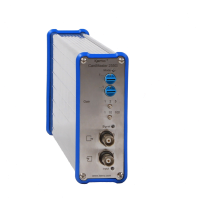
1 Channel Mini Rack
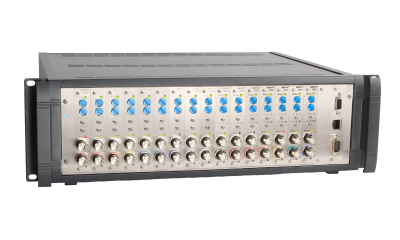
Up to 20 Channels in a 19″ Rack
The Kemo CardMaster 21.255G is a filter card designed for applications requiring occasional manual adjustment of cut-off frequency and gain. The CardMaster 21.255G can be fully controlled via the optional interface, using windows interface commands sent over Ethernet. Cut-off for each channel is set using two front panel hexadecimal rotary switches, and gain by two front panel switches. CardMaster 21.255G is a member of the Series 21 family of signal conditioning components and can be used in mixed systems comprising different cards from the Series 21 filters. Gain of 1, 2, 5, 10, 20, 50, 100, 200 and 500 is set by front panel switches. Input configuration is set by on board jumpers.
Up to 20 CardMaster 21.255G s can be fitted to the Kemo 21.20 rack, or 1 in the compact portable DC powered minirack.
The CardMaster 21.255G is based on the Kemo 1600 Series filter module, to provide a filtering solution for applications where filter cut-off frequencies need to changed.
The frequency range of a CardMaster 21.255G card is expressed in terms of its ‘base frequency’ ff; the card can be set to any frequency between ff and 255ff, in steps of ff. Cards can be ordered with base frequencies ranging from 1Hz to 500Hz on a 1/2/5 scale. We make the most appropriate combination from 1200 Series filter modules and controlling components. Frequency setting 255 is filter bypass.
| Frequency Range / Hz | Steps | Frequency Range / Hz | Steps |
| 0.2 – 50.8 | 254 x 0.2 Hz | 20 – 5 080 | 254 x 20 Hz |
| 1 – 254 | 254 x 1 Hz | 50 – 12 700 | 254 x 50 Hz |
| 2 – 508 | 254 x 2 Hz | 100 – 25 400 | 254 x 100 Hz |
| 5 – 1 270 | 254 x 5 Hz | 200 – 50 800 | 254 x 200 Hz |
| 10 – 2 540 | 254 x 10 Hz | 500 – 127 000 | 254 x 500 Hz |
Full Specification
| Channels | 1 channel per card, 1 slot in Kemo rack |
| Control | Filter cut-off and gain set by front panel switches. Other parameters by on board jumpers or selectable components. Optional External control, 10BaseT text based FICL II interface. (19″ rack only) |
| Frequency | 254 cut-off steps, and filter bypass |
| Gain | 1, 2, 5, 10, 20, 50, 100, 200, 500, (+54dB) with optional factory fitted output Attenuation |
| Filters | 1600 series filter modules |
| Filter Responses | Defined by filter modules. Filter Responses |
| Input Coupling | AC / DC, Single ended / differential set by internal jumpers |
| Input Overload | Absolute Input overload (single ended or differential) |
| IEPE | 4mA 24V current source ( selectable 1-10mA ) |
| Signal Level | +/- 10 V pk-pk. (Usually with ‘headroom’) |
| Signal Offsets | +/- 50% on output, +/- 50% on output single ended only. Factory fitted option. |
| Signal Level Indication | 3 colour, 4 signal level, off / green / orange / red |
| Size | 1 Series 21 slot (100x220mm Eurocard) |
| Racks, Size and Weight | 21.20 Rack(19″ 3U) – up to 18 channels, 420 x 155 x 350mm (16.6 x 6.1 x 13.8″), 10 kg, (22 lb) maximum. 21.1 Minirack – 1 channel, 44 x 116 x 270 mm (1.7 x 4.6 x 10.7″) 1 kg ( 2.2 lb) maximum. |
| Power | 21.20 rack 90 -120/180-240 Vac 50/60Hz – Optional DC power 21.1 minirack 9 – 30V DC power |
Easy Control
The frequency and gain are set by front panel switches. Controls for IEPE, AC/DC input coupling, and single ended / differential input are set by on board jumpers.
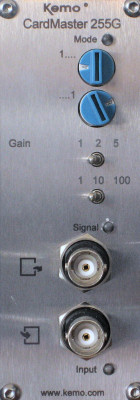 |
Filter frequency value set by front panel BCD switches ’16’s switch |
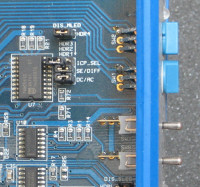 |
|
‘1’s switch x1, x2, x5 gain switchr> |
||
| Signal level indicator | Jumpers controlling IEPE Single ended / differential AC/DC |
|
| Input overload indicator |
Filter Responses
The CardMaster 21.255G has been updated to add the standard range of Kemo filter responses
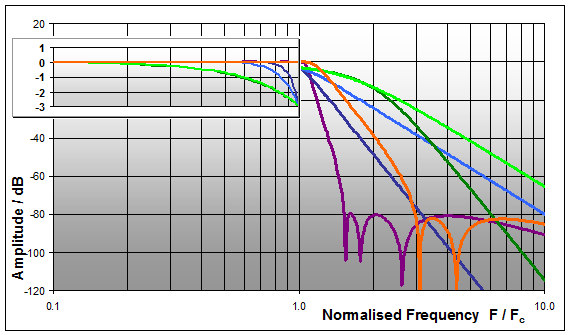
These are:- Butterworth 4 pole (05), and 8 pole (03), Bessel 4 pole (09 ) and 8 pole (07 ),
Sharp anti-Aliasing type, flat to filter cut-off, (13)
General purpose, flat to cut-off, linear phase(41 )
General purpose 6 pole (37), compatible with earlier versions of the BenchMaster 21M ( or VBF 21M)
The filter response is specified at Order, any questions about which one, contact us and we are pleased to advise you.
Inputs and Gain
From our experience of signal filtering we have included a versatile set of input configurations and gain on the CardMaster 21.255G. Each channel can be independently configured.
Inputs – AC or DC coupling, set by on board jumpers. Input Mode – Single ended or differential, set by on board jumpers. Note:- AC Coupling is on both inputs of differential input. Transducer Power – current source for IEPE transducers, 24V 1-10 mA, set by user selectable resistor, factory set value, 4 mA. Input Gain – set on front panel, two switches, x1,x2 (+6dB),x5 (+14dB) and x1,x10 (+20dB),x100 (+40dB), to give 1,2,5 steps to x500 (+54dB). All the above settings can be controlled by the external Ethernet interface. Trims – Gain and DC offset can be trimmed by multi-turn pots on the board. Output Attenuation – if required the output can be passively attenuated.
Block Diagram of CardMaster 255G

Signal Level Indication
CardMaster 21.255G cards have a signal level indication LED fitted between the input gain stages and the filter.
Signal level indication:- 0%- off -10% – green – 70% – orange – 95% – red.
Optional Signal Offset
CardMaster 21.255G cards are now fitted with additional offset on the single ended input, and on the output, up to +/- 5V offset can be applied to the signal making them suitable for use with 0-5V or similar unipolar data acquisition systems.
Special External Control
The Kemo 21.20 rack and CardMaster 21.255G cards are designed for fitting special connectors. These can be fitted to the rear panel, or to a spare slot on the front. Typically we have fitted 25 way ‘D’ type connectors, with all the filtered outputs on one front panel connector. We have also fitted customer specific connectors to the rear panel. Let us know what you would like.
Optional External Control
CardMaster 255G filters are fitted with control logic compatible with the Kemo FICLII interface for external computer control.
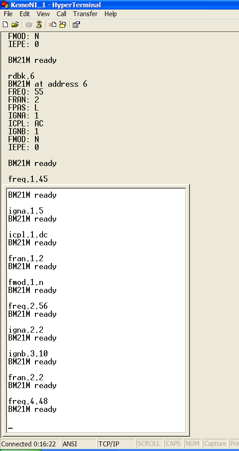
This is a text (ASCII) over a 10BaseT, RJ45 plug, Ethernet style hardware interface. This provides an operating system independent interface. the interface stores current data, verifies incoming commands, and then executes them. CardMaster 255F filter cards, like other Kemo units, are receive only on the rack control bus. More than one filter card can be set to the same address, they will all execute the same command. So one command can set a group of cards to the same settings.
Simple text commands are used, the screen image shows typical commands sent via HyperTerminal.
igna,3,1 – sets channel 3, input gain block A to x1.
freq,3,92 – sets channel 3, frequency to value 92 ( base frequency x 92)
igna,2,5 – sets channel 2, input gain block A to x5.
imod,2,se – sets channel 2, input mode to Single Ended.
icpl,2,dc – sets channel 2, input coupling to DC.
rdbk,2 reads back all the current settings for channel 2.
The RDBK (readback) command gives a listing of all the commands.
RDBK,A will readback all the settings for all 64 channels.
Typical response time to send commands to one channel and implement the settings is about 200mS. Typical response time to refresh all 64 channels is about 15 seconds.
The interface will accept text files, so complete set up information for multi-channel filter systems can be sent as one file. the RDBK files can be stored as text files, so test setups can be stored for measurement audit purposes. An infinite number of racks may be linked for channel counts above 8.
DC Power
DC power, 9-30V DC input is available as an option for Kemo 21.20 racks, with an AC ‘power brick’ to power the unit from mains when available.
Please check our page about DC Power.
LED Indicators
The LED indicators on the CardMaster 255G can be turned off by on board jumpers.

